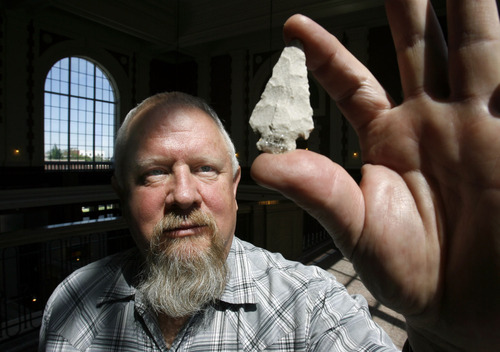This is an archived article that was published on sltrib.com in 2011, and information in the article may be outdated. It is provided only for personal research purposes and may not be reprinted.
The Utah Department of Community and Culture on Tuesday laid off the state archaeologist and two assistants, leaving the Antiquities section with just two employees: those responsible for maintaining a database necessary for development of roads, railways, buildings and other projects.
Department acting Director Mike Hansen said he was simply carrying out budget cuts ordered by the Legislature to eliminate programs that receive state funds and that do not carry out requirements of state or federal law. A plan from state Human Resources suggested consolidating the three positions into one new "forensic archeologist" job that will be posted Wednesday.
"The hard news today was we had to reduce three to one," he said. "We're very excited and hopeful to get a good response."
But assistant state archaeologist Ronald Rood, who was among those dismissed, said in a professional association website post that Utah "showed its disdain for archaeology and Utah's vast cultural heritage." In a separate interview with The Tribune, he said that no other programs in the state Division of History had been cut and suggested there may have been a political motive behind the change: to eliminate employees who sought to protect archaeological sites threatened by development.
Rood, along with state archaeologist Kevin Jones and physical anthropologist Derinna Kopp, who also lost their jobs Tuesday, stepped into the view of Gov. Gary Herbert, lawmakers and the Utah Transit Authority in recent years when they raised concerns about a proposed commuter rail station planned in Draper. UTA proposed the train stop and mixed-use development on the footprint of an ancient American Indian village, the earliest known location of corn farming in the Great Basin.
"We always have tried to stand up for archaeology," Rood said.
"We were pretty vocal over the issue of the [rail] station down in Draper that was going to be placed over a 3,000-year-old archaeological site."
Hansen flatly denied the suggestion the firings were politically motivated. When asked about any possible connection to the Draper FrontRunner station, he said, "absolutely not."
Allyson Isom, communications director for Herbert, also denied ulterior motives.
"Unfortunately," she said, "these cuts were mandated by the Legislature."
The Legislative Fiscal Analyst Office prepared a "menu" of $550 million of possible budget cuts, including $154,300 in potential savings by cutting two positions in the historic preservation program. While the Legislature did order reductions, the details of how to implement them were left to the executive branch.
"It isn't a statement on the value of archaeology," Isom said, noting that the Department of Natural Resources, the state Department of Transportation and the Public Lands Coordinating Council all employ archaeologists. "The state remains committed to archaeology in other offices. It is our heritage, our identity, and we have to preserve it."
The archeology team is part of the state Historic Preservation office, which was responsible, among other tasks, for reviewing archaeological sites in development zones, cataloging human remains found on state and private lands for repatriation to American Indian tribes in accordance with state and federal law, namely the U.S. Native American Graves Protection and Repatriation Act of 1990. The team also conducted educational programs for Utah's fourth- and seventh-graders and during an annual Archaeology Week with field trips and lecturers.
When they were asked to leave the building Tuesday morning, the three archaeologists walked away from partly written reports and forensic evaluations of about 100 sets of skeletal remains. About three were under active review in the laboratory.
The proposed Draper rail station had political tendrils reaching onto the UTA board — where trustee and developer Terry Diehl had an interest in development plans around the station — and the Legislature, where attorney and then-House Speaker Greg Curtis had pushed the Department of Natural Resources to delay a conservation easement planned for the site because a client wanted to trade for the land to develop the station.
But Herbert, a former president of the Utah Association of Realtors, won the praise of preservationists and tribes by ultimately signing a deal preserving 252 acres of the ancient American Indian village through a conservation easement granted to the nonprofit Utah Open Lands. UTA agreed to build its station and accompanying development farther north.
The archaeologists' dismissals come at a time when lawmakers have ordered the Department of Community and Culture to consider restructuring or even eliminating itself. HB287, sponsored by Rep. Wayne Harper, a West Jordan Republican and developer, requires the agency to improve efficiency, reduce the cost of government and "better focus the state and its employees."
Hansen said the firings and the review should not be confused. And, if it's found the reorganization of the archeology office hasn't worked, the office could possibly be reorganized again.
"This [Herbert] administration is about efficiency," Hansen said.
Forrest Cuch, former longtime Utah Indian Affairs director, charged Tuesday that Utah will be in violation of state and federal law because of the firings. He added that he is convinced the archaeology professionals were snared in the Draper FrontRunner station controversy, just as he was. Cuch was fired in February for what the governor characterized as "insubordination."
Cuch, who disputed the official reason for his termination, also said a federal investigation is in order in the archaeology shakeup.
"It's time this stopped, this violation of federal law," Cuch said. "Some of these people need to be put in jail."
Indian Affairs • Shirlee Silversmith is the new director. › A10



